
When it’s time to layer up, these women’s ski jackets have what it takes to keep you warm and protected on the mountain. Photo: Chase Boyd//The Inertia
The ski outerwear market is saturated. You know it, and we know it. But the reality is you really only need one – maybe two – ski jackets to get you through a season (and hopefully many more). With that in mind, we considered factors ranging from durability and waterproofing to breathability and weight in our search for the best women’s ski jacket. Functions and features were, of course, strong considerations as well. And we certainly didn’t neglect style, cut, and fit. If you’re gonna shred hard, it’s worth looking good, too.
We did the research and got our hands on more than a dozen different jackets to put to the test. And last season certainly did just that. From storm days to bluebird days, in the rain, dense “Sierra Cement,” and blower powder, we tested these jackets in all of the variable conditions that the season had to offer, and here we give you our choices for 2025/2026. The jackets we include in this list not only survived, but thrived in these tough conditions with the functionality to keep us dry, warm (but not sweaty), and looking stylish until the last bell.
Navigate To: Comparison Table | How We Tested | Buyer’s Guide
Related: Best Women’s Ski Bibs | Best Men’s Ski Jackets | More Ski Gear Reviews
The Best Women’s Ski Jackets
Best All-Around Resort Skiing Shell Jacket: TREW Gear Stella Primo Jacket
Best Women’s Resort/Backcountry Jacket: Flylow Lucy Jacket
Best Women’s Budget Ski Jacket: Mountain Hardwear Women’s Firefall
Best Women’s Insulated Ski Jacket: Helly Hansen Powderqueen 3.0
Best Women’s Backcountry Ski Jacket: Black Diamond Women’s Recon LT
Best Features on a Women’s Ski Jacket: Rab Women’s Khroma Latok
Best All-Around Resort Skiing Shell Jacket
TREW Gear Stella Primo Jacket ($499)
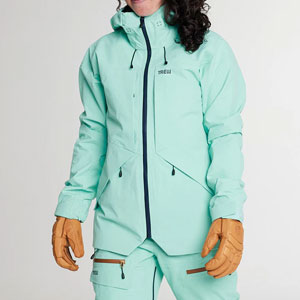
Weight: 814 g / 1 lb 12.7 oz
Fit: Relaxed/freeride (but not as relaxed as other freeride styles)
Pros: The breathability of a shell with the durability of a resort-specific jacket, great color options
Cons: Material is a little heavy, pockets can be slightly difficult to access due to storm-proofing flaps
The Stella Jacket is a tried-and-true member of Trew’s collection, and for good reason. It is durable, capable, and comes in colors to die for. The Stella Jacket puts function and style on equal footing for the female skier who is interested in skiing from bell to bell at the resort.
The material is fully recycled, always a plus in our book, and the features and weatherproofing are top-tier. If getting the most hours possible at the resort is your goal, this may be the jacket for you. Our tester enjoyed the large pockets, meaning you can save some weight by ditching the backpack. GoPros, sandwiches, and more disappear easily into the roomy pocket design. Plus, this jacket is rated to be 20k waterproof and breathable, so our tester found the elements never posed problems, no matter how nasty the weather. Even better, the seams are fully taped.
While the material is slightly heftier than some other jackets we tested, such as the Rab Women’s Khroma Latok GORE-TEX Pro Jacket, this is understandable, given that the shell is designed for in-bounds skiing. That said, the pit vents and 3L, uninsulated design mean this jacket could certainly be used for touring if you really refuse to buy a backcountry-specific jacket, and it goes without saying that this thing is spring-skiing ready.
The features leave little to be desired: a removable powder skirt, adjustable velcro wrist cuffs, a helmet-compatible hood, and a RECCO reflector all add to confidence, no matter where you’re skiing. Bonus points to TREW for offering a variety of color options, all the way from hyper-feminine pastel purple to burnt orange (our tester’s favorite) to classic black. It is a close call between the TREW Stella and the Arc’teryx Sentinel (below) for Best Overall Women’s Ski Jacket. Both are fully-featured, comfortable, and durable. We found the nicer material of the Sentinel to be a solid comfort upgrade over the Stella (the Sentinel also has a soft interior lining), but had trouble justifying the $250 upcharge that comes with the Arc’teryx Sentinel at $750. However, if you have the room in your budget, the Sentinel is a worthy upgrade.
CHECK PRICE ON Backcountry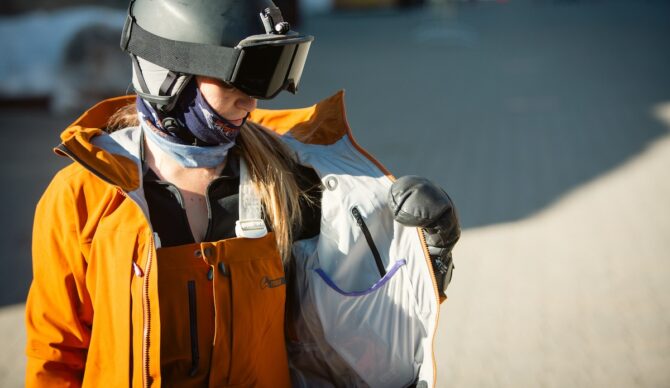
Photo: Chase Boyd//The Inertia
Best Women’s Resort/Backcountry Ski Jacket
Flylow Lucy Jacket ($420)
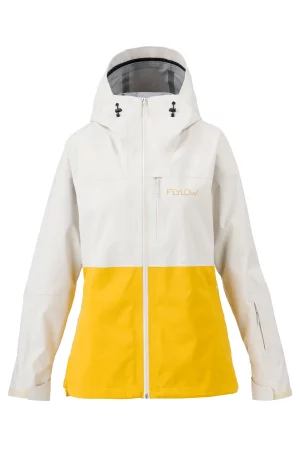
Weight: 612 g / 1 lb 5.6 oz
Fit: Slimmer than other jackets, making it tighter over extra layers
Pros: Accessible pockets, 12-inch pit zips, and PFC-free DWR
Cons: Lighter colors show dirt easily, trim fit may require sizing up to better accommodate layering underneath the jacket
When we shop for new outdoor gear, we want it to serve multiple purposes. The Flylow Lucy Jacket exemplifies gear that does double duty, so you only have to invest in one jacket to switch between chair-accessible and backcountry adventures. Lightweight but durable, stylish but full of features, this versatile outer layer will shield you from winter storms and ominous rain, but it will also breathe on the bootpack.
Lighter than many other jackets we’ve tested, the Lucy is better for milder winter days than frigid ones. The athletic fit was less accommodating of thicker insulation and midlayers, but with only a baselayer against our skin, we stayed at the perfect temperature on warmer and higher-output days, such as a 30-run ski day on Mt. Hood or a 2,000-foot ascent on the alpine trail. That, coupled with its packability, accessible pockets, and 12-inch pit vents, makes it a top-tier option for the skier who splits their time between in and out of bounds.
While we are huge fans of the variety of colorways the Lucy is available in, one downside of the lighter shades is that they show dirt and stains more easily. However, because the DWR coating is free of PFCs, you should wash the jacket more often anyway to keep the water-repellent outer coating performing at its best. Another minor downside is the trim fit, which our tester found to be a bit restrictive when layering up with a puffy jacket underneath. Check the size charts, and consider sizing up. It was a tough choice between this jacket and the Rab Khroma Latok for Best Resort/Backcountry Jacket. In the end, the high price point of the Khroma Latok pushed it further down the list, but we decided to give it some props as the jacket with the best features. The bang-for-buck of the Lucy jacket is top-tier, but if price is less of a concern, we’d likely point you towards the Khroma.
Read our full review of the Flylow Lucy Jacket here.
Check Price on Backcountry
Photo: Amelia Arvesen//The Inertia
Best Women’s Budget Ski Jacket
Mountain Hardwear Women’s Firefall Insulated Jacket ($269)
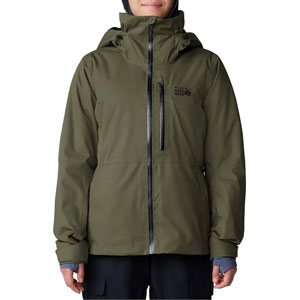
Weight: 950 g / 2 lb 1.5 oz
Fit: Standard
Pros: Great price, comfortable fit, venting system, adjustable hood
Cons: pockets could be deeper, insulated (resort-specific), color options
With a comfortable fit, breathable shell fabric, insulation for simplified in-bounds skiing, a helmet-compatible hood with a drawcord, zip vents, pockets galore, and even a powder skirt with pant integration, at $289 (a fraction of what other insulated jackets, such as the Flylow Charlie Coat ($600), go for), the Firefall is a steal for those who ski strictly lift-accessible terrain and want a do-it-all jacket without shelling out the big bucks.
The only aspects of this jacket that could be improved are the features and color options. The pockets, while definitely providing enough storage to get through a full day of skiing, would be even better with deeper inner pockets. In terms of style, the color options are fairly limited, but they have been updated this year to more muted colors, rather than the splashy colors of last year that weren’t our favorites – and it’s also offered in classic black, which goes well with anything. But again, it’s a durable, capable jacket, and for under $300, you will be hard-pressed to find anything better.
CHECK PRICE ON Backcountry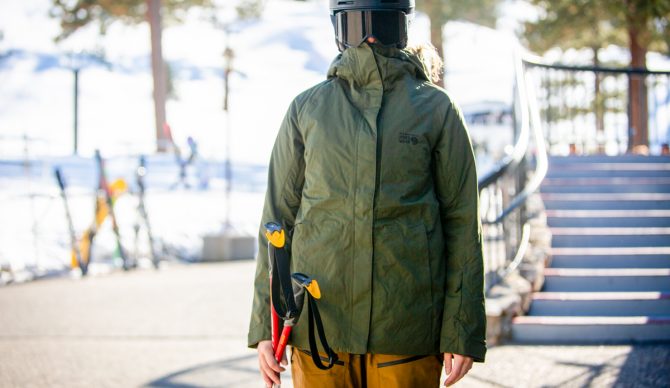
Photo: Chase Boyd//The Inertia
Best Women’s Insulated Ski Jacket
Helly Hansen Powderqueen 3.0 Jacket ($465)
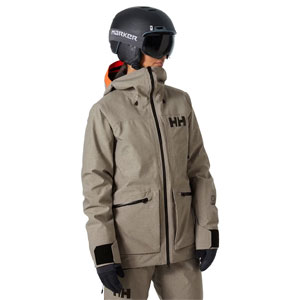
Weight: 1100 g / 2 lbs 6.8 oz
Fit: Average
Pros: Insulated, durable, ample pockets, helmet-compatible neon hood
Cons: Not as breathable as a shell jacket
This jacket surprised us with its durability. Bell-to-bell powder skiing in Sierra Cement? No problem. Fall down a chocolate-chip-studded chute and come out without so much as a rip in your coat? Check. If you’re looking for an insulated jacket that will survive cold temperatures, powder, and long days at the resort, this jacket is right up your alley.
What it lacks a bit in style, it makes up for in functionality and fit. That said, for an insulated jacket (which often looks frumpy as opposed to shells with separate underlayers), the Helly Hansen Powderqueen 3.0 has to be the best-looking one on the mountain.
There’s a reason Ski Patrol often chooses Helly Hansen for their uniforms: the durability and warmth of this thing is no joke. With nothing but a baselayer on underneath, our tester wasn’t the least bit concerned about getting cold in the coldest of temps on offer (given, it’s the West Coast). Truthfully, she was a little worried about overheating, but the breathability was a lot better than comparable insulated jackets, and you can spend a lot more for comparable quality, such as with the Flylow Charlie Coat, so it’s hard to complain. And the seam-sealed, super-durable shell of this jacket was worth it on deep days. Her notes read, “I stayed out for 8 hours in a blizzard without issue. Did not need to layer. Got a little sweaty but never hot or cold.”
With tons of pockets (including a ski pass pocket), a powder skirt, helmet-compatible hood (with the classic HH neon flare), elastic cuffs with thumbholes, and Recco technology, this jacket is an obvious choice when you’re switching your goggles out for a storm lens and it’s coming down hard out there.
The main downside of this jacket is the reduced breathability due to the insulated and 2L construction, which certainly makes this jacket less versatile than a 3L shell jacket. The color choices are surprisingly pretty, with muted greens and purples to choose from, but weirdly, there is no classic black option at this time.
CHECK PRICE ON Helly Hansen CHECK 2024 PRICE ON Backcountry
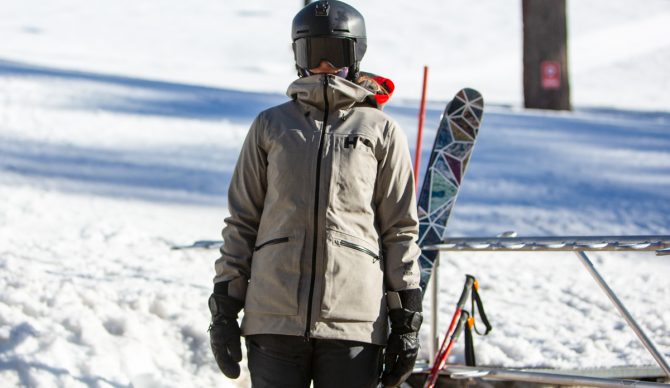
Photo: Chase Boyd//The Inertia
Best Backcountry Women’s Ski Jacket
Black Diamond Women’s Recon LT Shell ($450)
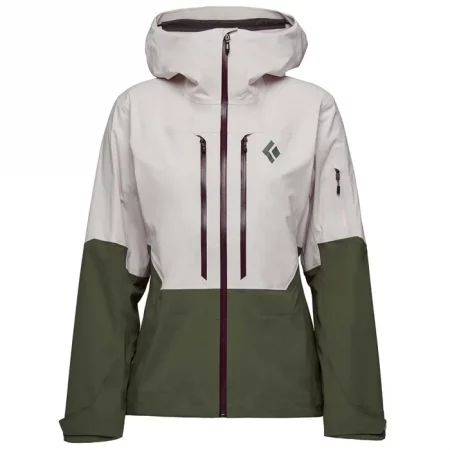
Weight: 427 g / 15 oz
Fit: Regular
Pros: Incredibly lightweight and breathable, soft/stretchy, fun colors
Cons: Lacks pockets/features
Most things Black Diamond makes have a preference for the backcountry. The Recon LT Shell Jacket takes that preference to the extreme, shedding tons of weight without compromising waterproofing or windproofing. The four-way stretch material is exceedingly comfortable and allows for completely unrestricted movement, something surprisingly hard to find in a true shell jacket.
The pit zips are large and allow for plenty of ventilation if the lightweight and breathable material isn’t enough for your exertions on the uphill. Underneath, there is enough room to layer, although this jacket is slightly more fitted than the other jacket we tested from Black Diamond, the slightly heavier and more feature-rich Recon Stretch Shell, featured further down, and a favorite of ours for mixed resort and backcountry riding.
That being said, the features are not lacking on this backcountry shell, especially when considering most skiers wear a backpack when venturing off-piste. Plus, the price point, at a reasonable $400 (compared to the near-double price point of $750 for the Arc’teryx Sentinel Jacket), seals the deal. A helmet-compatible hood, adjustable drawcord hem, zippered pack-compatible hand pockets, adjustable velcro cuffs, and a zippered pass pocket are all packed into this lightweight shell.
Because this jacket is designed for the backcountry, it would not be our first choice for in-bounds skiing. While it is fully featured, it lacks interior pockets, and the two large hand pockets + small upper-arm pass pocket provide enough room for essentials if you’re carrying a backpack, but don’t provide the level of organization we’ve come to expect in a resort-skiing shell. Additionally, it may not be the best option for intensely cold or stormy chairlift-accessed skiing due to its breathability. And while it is fairly durable, especially for such a lightweight jacket, it’s not up to the same standards of toughness as a true resort shell.
As noted, though, it is not marketed for that, and this is in no way a strike against this jacket. If your primary concern is low weight, combined with top-tier waterproofing, windproofing, and breathability for alpine touring, this is the jacket for you.
CHECK PRICE ON Black Diamond CHECK PRICE ON Backcountry
Best Features on a Women’s Ski Jacket
Rab Women’s Khroma Latok GTX Jacket ($680)
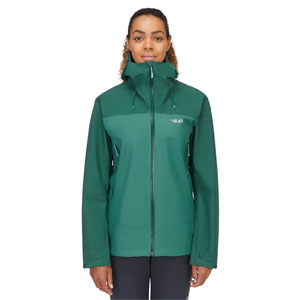
Weight: 546 g /1 lb 3.2 oz
Fit: Fitted, with room to layer
Pros: Attention to detail, durability, 3L GORE-TEX Pro 28,000mm waterproofing/windproofing, partially recycled materials
Cons: Expensive, limited color choices
The Khroma Latok Jacket, without question, rose to the top of the list out of every jacket we tried. At 546g, this jacket is lightweight enough to tour with (and lighter than even most other high-end backcountry options here, such as the Ortovox 3L Guardian Shell at 741 g), yet still extremely durable and more than wind/waterproof enough for any big day in serious conditions. This is the jacket we would trust no matter what the day brings. Somehow, it looks good, too.
The functionality is of the highest standard: every single aspect of this jacket has been engineered for the hardcore skier. For example, the zippers are extra-large to make opening and closing the front a breeze, even with thick mittens on.
While this jacket is designed for the backcountry, it is more than capable of handling anything skiing in-bounds throws your way: blower pow, rain, sleet, high winds, or a bluebird spring ski day. With two weights of GORE-TEX Pro Most Breathable to balance protection, weight, and breathability, the jacket is flexible, durable, and breathable, a rare combination. With heavier-duty fabric across the shoulders and outer sleeves, the jacket can withstand almost all scrapes and falls. The lighter-weight fabric around the core allows for lower overall weight and bulk, greater mobility, and improved breathability.
The length is perfect as well: not too short, and not so long that it looks strange or impedes movement. Powder is no match for getting inside this jacket, and we tested it out on some proper powder days (4 feet coming down in one day, to be exact). The features are also impeccably designed: inner and outer pockets that are accessible even with a backpack on, a two-way adjustable, helmet-compatible hood, and a stretch Matrix powder skirt you won’t notice unless you need it.
The only aspect of this jacket we could find fault with was the limited color selection, but even that is a stretch, as the colors offered are not offensive in the slightest: the choice between deep maroon, muted green, slate grey, and bright blue should have something for most, but the absence of black or tan is odd, considering this jacket could easily be a staple for any dedicated skier.
Complete with a 100% recycled face fabric, the Khroma Latok Jacket leaves nothing to be desired and allows you to focus on the parts of skiing that should require your attention, like avalanche safety, reading the conditions, and choosing lines in and out of bounds.
CHECK PRICE ON BACKCOUNTRY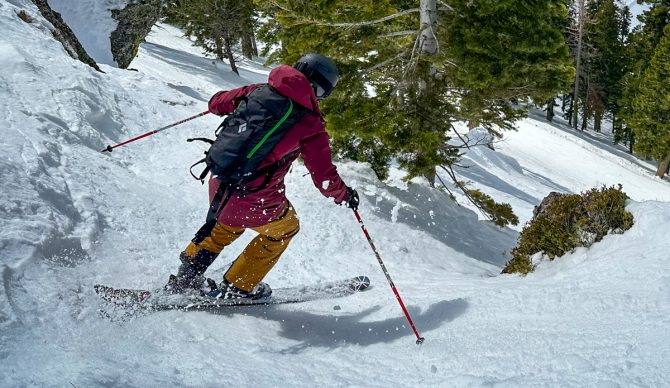
Photo: Chase Boyd//The Inertia
Best of the Rest
Runner-UP Best Women’s Resort Skiing Shell Jacket
Arc’teryx Sentinel Jacket Women’s ($750)
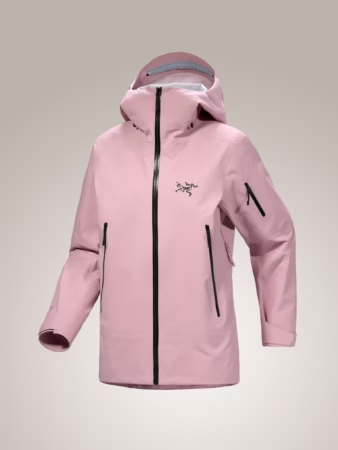
Weight: 605 g / 1 lb 5.3 oz
Fit: Regular
Pros: Comfortable, stylish, durable, holds up in all conditions
Cons: Limited color selection, expensive
The Sentinel Jacket from Arc’teryx brings everything to the table that we know and love about Arc’teryx, with the benefit of a freeride-style cut (read: roomier, comfier, and a little more stylish in today’s world).
The fabric feels luxurious, maintaining durability without feeling stiff thanks to a brushed interior backer. On the technical side, the 3L GORE-TEX fabric ensures wind protection and dryness on even the stormiest of days. The hood actually fits well over a ski helmet, one of the best fits we’ve experienced, and the pockets are large enough to fit most things you could need for a day of skiing at the resort.
The fit of the classic Sentinel jacket is about as down-the-middle as you can get. Neither baggy nor truly fitted, the jacket provides ample room for layering, but we suggest sizing up for a true “freeride” fit.
For the backcountry, this jacket is surprisingly light, even when compared to dedicated backcountry shells, making it a decent option for occasional journeys outside of the resort. However, that brushed interior lining will add a bit of warmth, worth considering for the uphill. For a backcountry-specific hardshell from Arc’teryx, check out the Women’s Rush Jacket.
For 25/26, the jacket sports a new GORE-TEX ePE membrane and face fabric that claims to be lighter and thinner, without compromising durability. We have yet to get out there with this updated fabric and will update our review once we do so this season. The jacket is offered in black, light pink, dark blue, and bright orange, some of which may feel a little flashy, but the classic black is always an option, and pairs well with just about any bib you already have in your closet. Our Best Resort Skiing Shell Jacket, the TREW Stella, saves you $250 with slightly heavier material, and without the comfort of the brushed interior lining, but if your wallet can handle the price of the Sentinel, you won’t be disappointed.
Editor’s Note: The jacket we initially tested for this review is the Sentinel Relaxed Jacket, a roomier freeride version of the classic Sentinel. With the Sentinel Relaxed being discontinued this season, our review now speaks to the classic Sentinel Jacket, which saw some fabric updates this season, and we’ll be testing the latest version as soon as the snow falls this winter.
CHECK PRICE ON Arc'teryxRunner-Up Best Resort/Backcountry Ski Jacket
Black Diamond Women’s Recon Stretch ($500)
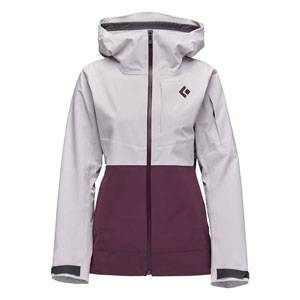
Weight: 667 g / 1 lb 7 oz
Fit: Normal, room to layer but still reasonably fitted
Pros: Lightweight, extremely durable, designed for optimal functionality in all conditions
Cons: Lacks an inside zip-able chest pocket, main zipper slightly harder to zip than others due to waterproofing
Black Diamond blew us away with the Recon Stretch Shell jacket, a true one-jacket solution for backcountry enthusiasts, powder hound ski bums, hardcore 150-days-a-year skiers, and everyone in between. With seamless comfort, impressive breathability, windproofing, and durability made to last (with a practical lifetime warranty, to boot), although the color options leave a little to be desired, this is true ski outerwear performance at its finest. The price point, at a reasonable $450, seals the deal.
While this jacket is marketed as a hybrid, it is actually lighter than many backcountry-specific shells of the same variety. Even better, it somehow retains body heat better than backcountry-specific shells, meaning less packing of unnecessary layers for all but the coldest days.
The Recon Stretch Shell combines a durable 4-way stretch fabric (it really is noticeable, think Lululemon NuLux fabric versus regular cotton leggings to work out in) with their waterproof/ breathable solution, BD.dry, for a jacket that is designed to be capable of a full day of skiing in or out-of-bounds.
Our tester noted how intuitive the temperature regulation was while wearing this jacket. She did multiple bootpacks at Palisades Tahoe, descended icy chutes, ripped moguls until her quads were sore, cruised around with friends on the groomers, sat for significant periods of time without moving, and never felt too hot or too cold.
The only area this jacket could improve on was in regards to the features. While this jacket has all the pockets you could need, including a chest pocket and two mesh internal drop pockets in addition to the standard side pockets, our tester (and many skiers) prefer to store phones inside the shell near their chest, where some jackets offer a final, zip-able interior pocket. While not a deal breaker, it would be a nice improvement to see in the future. We also found the front zipper to be a bit harder to zip and unzip than other jackets we tested due to the waterproof construction.
What elevated other hybrid jackets like the Flylow Lucy and Rab Women’s Khroma Latok jacket over this one to be included in our top picks is the quality and lightness of the materials used in those two shells. In the case of the Khroma Latok, which weighs a mere 546 g, it is the insane durability and performance of the GORE-TEX Pro Most Breathable material. However, it costs a pretty penny ($680), and the awesomeness of GORE-TEX Pro Most Breathable is best appreciated on the skintrack rather than at the resort. With the Flylow Lucy Jacket, it is the relative lightness (612 g) and extreme comfort of the buttery soft and breathable material.
CHECK PRICE ON Black Diamond CHECK 2024 PRICE ON Backcountry
Runner-Up Best Insulated Jacket
Flylow Charlie Coat ($599)
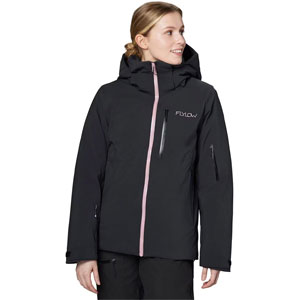
Weight: Not listed
Fit: Regular
Pros: Down insulation, color options, weather-resistant, durable
Cons: Fit
Flylow’s Charlie Coat brings the heat, packing 700-fill down insulation into a top-tier waterproof/breathable shell. This jacket is on the snug size, so definitely size up if you are in between sizes. Our tester found this jacket to be slightly more fitted than other similarly marketed insulated jackets, such as the Helly Hansen Powderqueen. Keep in mind, our tester does prefer relaxed fit jackets, but between all of the jackets she tested for this review, the Charlie Coat was definitely on the slimmer side, with only a bit more room than the Ortovox Guardian Jacket.
That being said, the Flylow Charlie Coat comes in some gorgeous color options, is extremely stretchy and soft for an insulated jacket, and would be a great option on a colder storm day. The seams are fully sealed as well, meaning you can feel confident about staying dry even if you stay out until the last chair.
The 700-fill down insulation is also surprisingly breathable, a huge plus for those who will still work up a sweat in the coldest of conditions. While it is only rated at 10k for breathability, with insulated jackets, breathability typically is not the number one concern. Our tester found this jacket to be breathable enough on all skiing days below freezing. Another bonus is the larger-than-normal underarm zips, providing solid venting if it is a warmer day or you’re bootpacking somewhere.
With a removable powder skirt, internal and external pockets, and an adjustable hood, this jacket has everything you could need for a day of cold or stormy skiing inbounds.
CHECK PRICE ON BACKCOUNTRYStio Women’s Figment Jacket ($500)
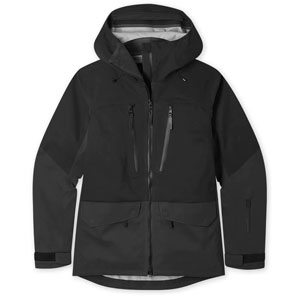
Weight: 765 g / 1 lb 11 oz
Fit: Relaxed
Pros: Lightweight, plenty of pockets, beautiful color options, seamless fit
Cons: Waterproofing
The Stio Figment Jacket is lightweight, stretchy, and has an effortless outerwear-without-being-outerwear feel to it. Precisely what we are looking for in a touring shell, this jacket makes a great option for touring, even though it is slightly heavier than a true backcountry-oriented shell.
The jacket feels extremely breathable for being given a low rating of 10,000 mm. Our tester noted that she never felt too hot or sweaty, and the zip vents add to its appeal to take into the backcountry. The features do not disappoint either, with the helmet-compatible hood, inner mesh pockets, goggle wipe (something you don’t think about, but definitely use!), and the storm-sealing hem.
The only major downsides of this jacket are the waterproofing and the durability. While Stio’s Figment Jacket is marketed to have a waterproof rating of 20,000mm, our tester found it to be less confidence-inducing on truly rainy days than, for example, the Rab Khroma Latok or other similar, lightweight shells.
That being said, this jacket fit almost perfectly, was stretchy enough to allow for a full range of movement without feeling overly thin, and looked great (for apres, too, not just the skin track). The light color options leave this jacket susceptible to oil stains, dirt smudges, and things of that sort, but, of course, you can always go for classic black, so this isn’t a fault of the jacket itself.
CHECK PRICE ON BACKCOUNTRY
CHECK PRICE ON STIO
Strafe Outerwear Women’s Lucky Insulated Jacket ($500)
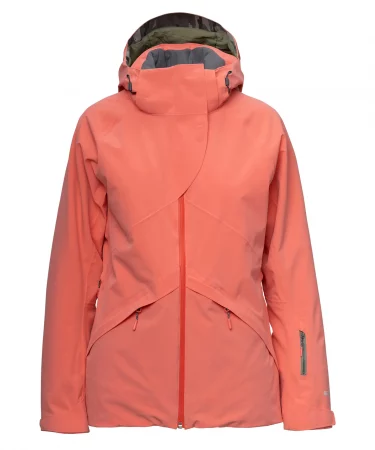
Weight: 840 g / 1 lb 13.6 oz
Fit: Regular
Pros: Warmth, interesting stylistic design, vent system, great fit
Cons: Features, breathability
Strafe’s Lucky 2L Insulated Jacket is a solid option for anyone who skis a colder resort: think East Coast or Colorado. This jacket combines the best of both worlds with the warmth of an insulated jacket and the venting system of a shell. The 4-way stretch ensures a seamless fit, which greatly impacts the comfort of a jacket. That kind of thing matters exponentially when you wear a jacket all day long, and with the Women’s Lucky Jacket, you can and will.
This jacket is also a top choice for storm days with its powder skirt, water-resistant zippers, and removable helmet-compatible hood. The removable hood is extremely useful and something a lot of jackets surprisingly do not offer. Not only for the weight difference, but the sensation of not being dragged down by the extra fabric in the back makes a world of difference when spring rolls around or you want to cruise groomers on a bluebird day.
Sporting a 2L construction, this jacket is similarly built to the Mountain Hardware Women’s Firefall Insulated Jacket. However, the Strafe Lucky Insulated Jacket is quite a bit more expensive than the Mountain Hardware option. It does fit considerably better and looks quite a bit sleeker, so if appearances matter to you on the hill more than saving a couple of hundred bucks, you may opt for the Strafe Lucky over the budget-friendly Mountain Hardware option.
Like any insulated jacket, however, it poses the issue of not being quite as versatile as a shell. That said, that decision comes down to the personal preference of the skier above all else, and did not dock this jacket any points in our ranking process.
CHECK PRICE ON Strafe OuterwearOrtovox 3L Guardian Shell Jacket ($820)
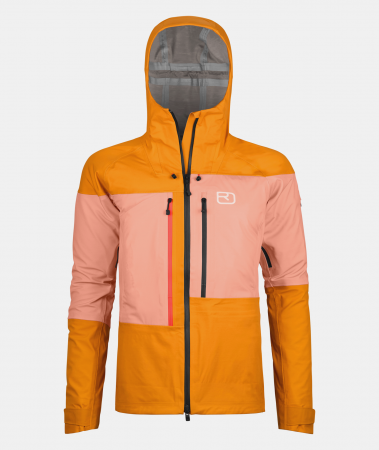
Weight: 741 g / 1 lb 10 oz
Fit: Slim
Pros: Stormproof, iconic style, ease of movement, lightweight but still durable
Cons: Cut is very slim at the waist
The Ortovox 3L Guardian Shell Jacket is a capable, durable shell perfect for intense backcountry missions or everyday lines in the resort. The only major downside of this jacket is that it runs slim, making it difficult to layer more than one underlayer, and the fit in the hips is very slim, unlike the other women’s jackets on this list.
If you are a woman who dislikes traditional women’s cuts, this may be the perfect jacket for you. However, it is marketed as a freeride jacket and fits more like a regular, fitted shell.
Nothing is sacrificed in the way of weatherproofing. This jacket can take on cold, windy, and wet days no problem, and feels slightly more capable in serious conditions than other jackets on this list, such as the Stio Figment. Impressively, it is also lighter than the Stio. This jacket is wind and waterproof but breathable, with 20k/20k waterproofing/breathability. It is soft, stretchy, and lightweight, so if the cut is for you, ease of movement is a breeze. The colorways, while extremely unique, were a plus for our tester, who enjoyed the iconic Ortovox look, and paired with black bibs, any color will look good.
The pockets and features also delivered: an adjustable storm hood, two-way front zipper, an inner pocket, ski pass pocket (a huge plus for the resort!), underarm vents, and a removable powder skirt. Overall, this jacket is a great choice for skiers who are looking for a slimmer and more fitted option for touring. This jacket could easily be a one-jacket solution to winter if you are someone who enjoys the backcountry and the resort equally.
CHECK PRICE ON ORTOVOX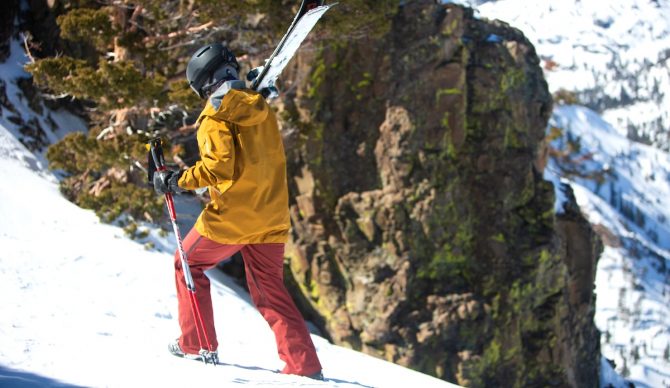
Photo: Chase Boyd//The Inertia
Best Women’s Ski Jackets Comparison Table
| Jacket | Price | Best For | Weight | Material/Waterproofing | Fit |
| TREW Stella Primo Jacket | $499 | Resort | 814 g / 1 lb 12.7 oz | 3L PNW material, 20,000mm waterproof/breathable | Regular |
| Flylow Lucy Jacket | $420 | Resort/ Backcountry | 612 g / 1 lb 5.6 oz | Tactic 3L 20k/20k softshell (100% recycled polyester) | Trim |
| Mountain Hardwear Women’s Firefall Insulated Jacket | $269 | Resort | 950 g / 2 lb 1.5 oz | Dry.Q 70D Textured Weave 2-Layer | Regular |
| Helly Hansen Powderqueen 3.0 | $465 | Resort | 1100 g / 2 lbs 6.8 oz | Shell: 100% polyester. Lining: 100% polyester (recycled). Insulation: 100% polyester (recycled) | True to size |
| Black Diamond Women’s Recon LT Shell | $450 | Backcountry | 427 g / 15 oz | BD.dry 3L stretch material | 20k waterproofing / 20k breathability | Regular |
| Rab Women’s Khroma Latok GORE-TEX Pro Jacket | $680 | Backcountry | 546 g /1 lb 3.2 oz | 80D recycled GORE-TEX Pro Most Breathable 3-Layer construction | Regular |
| Arc’teryx Sentinel Jacket | $750 | Resort/ Backcountry | 605 g / 1 lb 5.3 oz | 3L GORE-TEX, light flannel backer | Relaxed |
| Black Diamond Women’s Recon Stretch Ski Shell | $500 | Backcountry | 667 g / 1 lb 7 oz | BD.dry 3L material | 20k waterproofing / 20k breathability | Relaxed/true to size |
| Flylow Charlie Coat | $600 | Resort | Not listed | Intuitive Perm 2-layer fabric | True to size |
| Stio Women’s Figment Jacket | $500 | Backcountry | 765 g / 1 lb 11 oz | PeakProof 3L 100% recycled polyester, 150 Denier face fabric | Relaxed |
| Strafe Women’s 2L Lucky Jacket | $500 | Resort | 840 g / 1 lb 13.6 oz | Recon 2L material. 4-way stretch with DWR treatment | Regular |
| Ortovox Guardian Shell Jacket Women’s | $820 | Backcountry | 741 g / 1 lb 10 oz | 100% polyamide exterior, 100% polyurethane membrane, 100% merino wool interior | Relaxed (but fits slim, esp. in hips) |

A roomy freeride fit is one of the many winning features of the Arc’teryx Sentinel Relaxed Jacket. Photo: Chase Boyd//The Inertia
How We Tested The Best Women’s Ski Jackets
We rated each jacket on its durability, comfort, features, and breathability/ventilation. For consistency, we mostly tested only 3L shell jackets, focusing on all-mountain durability. We also tested a few insulated options, which we noted.
Our lead tester for this review is Ella Boyd, a born-and-bred East Coast skier who skied in Maine for almost 20 years before turning her attention to the West. During the 2023/2024 season, Ella got over 100 days under her belt at Palisades Tahoe/Alpine Meadows testing these ski jackets (as well as ski bibs).
Last season was a wonky season in the West: the perfect variable conditions for gear testing. Rainy days, powder days, bitterly cold days, and bluebird sunshine: we have seen it all. So have these jackets. We carefully considered every aspect of each jacket in making our recommendations, testing each one in the wild conditions on offer.

Testing the Flylow Lucy Jacket on Mt. Hood. Photo: Amelia Arvesen//The Inertia
We first published this review towards the end of the 23/24 season, and this fall gave it a quick refresh to include the most up-to-date versions of products and added more comparison information between options to help our readers make an informed purchasing decision. We continued testing this 24/25 season with Amelia Arvesen, who tested some top-pick resort/backcountry options, which we included here in our end-of-season update. In the fall of 2025 before the 2025/2026 season, we updated our picks based on current availability, and removed a couple of options that have been discontinued.

Putting the Arc’teryx Theriss (discontinued) to the test. Photo: Chase Boyd//The Inertia
Best Women’s Ski Jackets Buyer’s Guide
Features
Pockets
Pockets are easy to overlook when purchasing a ski jacket, but they are a secret weapon: the right amount of pockets doesn’t add extra weight, but also allows you to pack things on your person and omit using a backpack if you do it right. Even when wearing a backpack, pockets are useful for resort and backcountry expeditions (to hold things like skins, gloves, or a phone for music while going up and down the mountain).
Exterior pockets, often either on the chest or at the hip, are a necessity. Some jackets place those hip pockets higher up, so they’re still accessible with a backpack on.

Powder-proof pockets on the TREW Gear Stella. Photo: Chase Boyd//The Inertia
While we often rely on pants or bibs for beacon pockets, jackets can be holders of radios, phones, and other important gear you need quick access to in a pinch. Some pockets have weatherproofing in the form of seam-sealed zippers or flaps that cover horizontally-opened pockets. This can be a plus if you do a lot of powder skiing, but for the average day, it can be cumbersome and add time during critical moments, reaching for a ski pass, a quick snack on the hill, or anything else you may need in a pinch. For example, Black Diamond’s Recon Stretch Shell offers a jacket with waterproof seams, and the TREW Gear Stella Jacket, pictured above, has powder-proof coverings over the zippers.

Fully buttoned up for harsh weather in the Flylow Lucy Jacket. Photo: Amelia Arvesen//The Inertia
Hood
Look for the keyword “helmet-compatible hood” when purchasing, meaning the hood is big enough to accommodate your head with a helmet on. While helmet-compatible hoods are useful, without adjustability, they can feel massive. Two-way adjustability is even better, giving you the ability to cinch down the hood for wearing without a helmet. Some hoods are also removable, which is great if you ski somewhere where you see a lot of bluebird days.
Other Features
Features can be the difference between the absolute best jacket and the second-best ski jacket. Powder skirts, wrist gaiters, and large zippers to grab on to may feel silly on regular days, but on storm days, they become absolute necessities.
Wrist gaiters, a small, thin cuff with thumb holes that goes under your gloves and keeps out the snow, are a much-appreciated feature on a small number of the ski jackets included here. Rab, for example, included these in the Khroma Latok Jacket, and it elevated the performance of this durable shell on a powder day when the wind is blowing powder up and down the mountain. Wrist gaiters are truly a game-changer for keeping snow out of your sleeves, whether you prefer a gauntlet-style or an undercuff-style glove, a wrist gaiter will ensure no snow gets down to your inner layers.
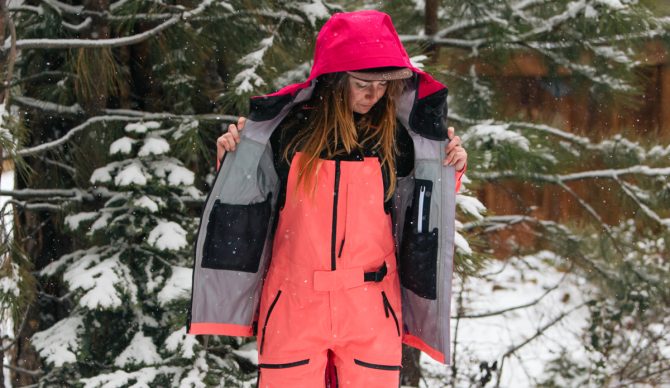
Pockets and ventilation are major pros of the Stio Women’s Figment Jacket. Photo: Ella Boyd//The Inertia
Breathability/Ventilation
If you’re looking for a one-jacket-quiver, you will need some sort of ventilation. Plenty of jackets are capable of touring and lapping the resort, and what sets this kind of jacket apart is the ventilation system, both in the material choices and in terms of features like pit-zips. It goes without saying that shells are going to be more breathable than insulated jackets, and you have the freedom to choose your own layering system as opposed to getting the same warmth every time. However, most jackets take things a step further with pit zips, one of the more commonly found methods for ventilation. The Stio Figment Jacket, Outdoor Research AscentShell Jacket, and Rab Khroma Latok Jacket are some options with zippered ventilation.

Burly material on the Helly Hansen Powderqueen 3.0 jacket earned it some points in the durability category. Photo: Chase Boyd//The Inertia
Durability
The definition of durability is an object’s ability to withstand damage, but with skiing, there is more to it than that. The elements can be damaging without directly damaging a jacket (think: wind, cold, snow, rain, grease from lift wheels), and then skiing itself can result in damage (rips from rocks, trees, poles, and you name it). A durable jacket should withstand these things and provide mental comfort that one fall, slip, or scrape in a glade will not result in a jacket that won’t make it through the rest of the season. Naturally, insulated jackets tend to feel heavier, but this does not necessarily mean they are more durable, unless it is in the name, such as with the Helly Hansen Powderqueen 3.0 Durable Jacket (which really is quite durable due to the Melange Ripstop fabric).
Shells can also feel more or less durable: think the Trew Stella Jacket, which is designed for the resort and the backcountry, versus the lightweight Black Diamond Women’s Recon LT Shell, which is designed with the backcountry in mind. Resort jackets tend to feel more durable than backcountry jackets, because durability tends to be inversely proportional to lightweight and breathability. However, these aspects do not have to be either/or (as shown by the Rab Women’s Khroma Latok and Flylow Lucy), but for the average consumer, where price point matters, you may be sacrificing breathability for durability or vice versa.

A high collar on the Flylow Lucy Jacket protects the face even with the hood down. Photo: Amelia Arvesen//The Inertia
Comfort
Comfort relates to both fit, such as relaxed versus fitted jacket styles, and also the softness of the material itself. Jackets lined with polyamide, such as the Helly Hansen Powderqueen 3.0, or with brushed inner fabric, such as the Arc’teryx Sentinel, lead to a more comfortable experience. Stretch can also affect comfort. Some jackets offer 4-way stretch, such as the Black Diamond Women’s Recon Stretch, which can enhance the comfort exponentially. Sometimes, there is a certain je ne sais quoi that makes one jacket especially comfortable for no apparent reason, and this simply comes down to personal preference.

Lightweight, stretchy material is a defining feature of the Flylow Lucy Jacket and matching Siren Bib. Photo: Amelia Arvesen//The Inertia
Material
The material of the jacket is, of course, integral to its performance. The unfortunate part is that you cannot have the best of both worlds: breathability and weight versus waterproofing and durability are somewhat inversely correlated.
As a general rule, look for GORE-TEX material in terms of waterproofing and durability, but, given the previous, it may not make GORE-TEX jackets the winner in terms of weight and breathability. Proprietary fabrics and DWR finishes like Black Diamond’s BD.dry, Flylow’s Perm HD fabric, and others follow close behind GORE-TEX, and may be superior in some cases, depending on the jacket’s other construction factors.
You may also notice the 2L vs. 3L descriptors of various jackets. Both of these construction types have a waterproof (but still breathable) membrane sandwiched by an exterior layer of material on the outside for durability and a lining on the inside to separate the waterproof/breathable membrane from your skin. The outside layer is then coated in a Durable Water Repellent (DWR) finish that keeps water from seeping in and adding weight, as well as reducing breathability. This DWR can wear out with use, but is easily revived with special washes.
In a 3L design, all three layers – inside, outside, and the waterproof membrane – are fused together, making for a single contiguous piece of fabric. This helps a jacket breathe better, and is also more durable as the waterproof membrane is protected both on the inside and outside. 2L material has the outer two layers fused together and the inside liner hanging separately. 2L material is also often used for insulated jackets, where the inside liner is replaced with layers of insulation. For backcountry touring and high-performance skiing, 3L material such as that on the Rab Women’s Khroma Latok is far and away the top choice for increased breathability and reduced weight, whereas if you’re just getting some laps in on the resort, a 2L jacket like the Mountain Hardwear Firefall will do the job.

Bootpacking in Backcountry’s Cardiac GORE-TEX Pro kit. This style was unfortunately discontinued last year. Photo: Chase Boyd//The Inertia
What is GORE-TEX?
GORE-TEX has been around for a while. Since 1969, in fact. GORE-TEX is just the name, given by W. L. Gore & Associates, for their waterproof, breathable fabric membrane.
GORE-TEX blocks liquid water while allowing water vapor to pass through and is designed to be a lightweight, waterproof fabric for all-weather use. In other words, it combines waterproofing and breathability, doing exactly what we need as skiers and what we all previously thought was impossible.
Nowadays, GORE-TEX comes in different constructions like GORE-TEX Pro (designed for increased durability) or GORE-TEX C-Knit (for increased breathability and low weight without sacrificing weatherproofing), among many others.
Return to Top Picks | Return to Comparison Table
Related: Best Women’s Ski Bibs | Best Men’s Ski Jackets | More Ski Gear Reviews
Editor’s Note: For more gear reviews and features on The Inertia, click here.


